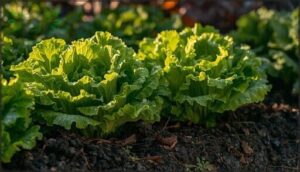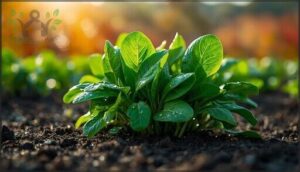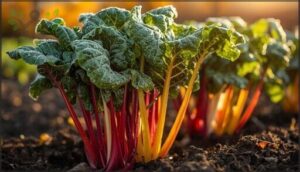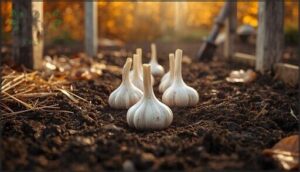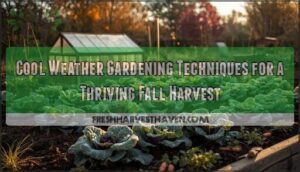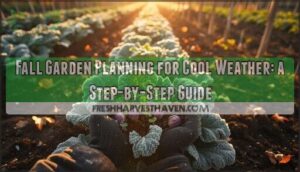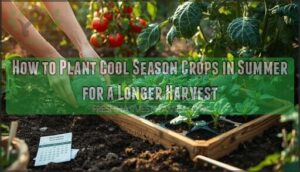This site is supported by our readers. We may earn a commission, at no cost to you, if you purchase through links.

If you think fall means winding down in the garden, you’re missing out on the best growing season of the year. Crisp air and cool soil set the stage for easy fall vegetables to grow—many thrive when summer’s heat sends others packing.
Radishes rocket from seed to harvest in weeks, lettuce and spinach stay sweet and tender, and kale shrugs off frost like it’s nothing.
With the right timing and a few clever tricks, you can keep your garden producing long after everyone else has packed up. Ready to turn chilly days into a fresh harvest? Let’s dig in.
Table Of Contents
- Key Takeaways
- Easiest Fall Vegetables to Grow
- Radishes—Fast-Growing and Foolproof
- Lettuce—Quick, Shade-Loving Greens
- Kale—Cold-Hardy and Productive
- Spinach—Speedy, Nutritious Leaves
- Beets—Simple Roots for Beginners
- Turnips—Versatile and Frost-Tolerant
- Swiss Chard—Colorful and Resilient
- Carrots—Sweet Roots for Cool Weather
- Arugula—Peppery, Fast-Maturing Green
- Garlic—Plant in Fall for Summer Harvest
- Best Fall Gardening Techniques
- Preparing Soil for Fall Vegetables
- Protecting Fall Crops From Cold
- Tips for Harvesting and Storing Fall Vegetables
- Frequently Asked Questions (FAQs)
- What is the easiest vegetable to grow in the fall?
- What is the easiest vegetable to grow for a beginner?
- What fall vegetables are easy to grow?
- What is the easiest plant to grow in the fall?
- When should I start my fall garden?
- What is the best vegetable to plant in autumn?
- What are some pest-resistant fall vegetable options?
- How to extend harvest time in colder areas?
- What tools simplify fall vegetable planting tasks?
- Can fall vegetables be grown entirely indoors?
- Conclusion
Key Takeaways
- Fall vegetables like radishes, lettuce, and kale actually thrive in cooler temperatures and taste sweeter after frost, making autumn an ideal growing season rather than a winding-down period.
- Success hinges on proper timing—plant most cool-season crops 8-12 weeks before your first frost date, adjusting for each vegetable’s specific maturity time and the slower growth that cooler weather brings.
- Simple protection methods like row covers, cold frames, and 2-4 inches of mulch can extend your harvest by weeks, keeping vegetables producing well past the first frost.
- Direct sowing works best for root crops that hate transplanting, while succession planting every two weeks ensures continuous fresh harvests instead of one big crop all at once.
Easiest Fall Vegetables to Grow
Fall gardening doesn’t have to be complicated, especially when you start with vegetables that practically grow themselves.
The crops below are beginner-friendly, forgiving of mistakes, and thrive in cooler temperatures.
Whether you’re planting your first garden or just want a stress-free harvest, these ten vegetables will set you up for success.
Radishes—Fast-Growing and Foolproof
Radishes are the speed demons of fall vegetables—ready to harvest in just 20 to 30 days. You’ll love varieties like ‘Early Scarlet Globe’ for quick yields or ‘Miyashige White Fall Daikon’ for impressive roots.
Plant seeds four to six weeks before your first frost, keep soil moist, and thin seedlings to prevent crowding. These beginner-friendly gems laugh at light frosts and actually taste sweeter in cool weather.
For best results, guarantee well-drained soil with a pH between 6 and 7.
Lettuce—Quick, Shade-Loving Greens
While radishes race to maturity, lettuce varieties take the scenic route—but you’ll still harvest tender salad greens in about a month. These leafy greens love partial shade and actually prefer cooler fall temperatures below 75°F, which prevents that bitter taste you sometimes get in summer.
Plant seeds 60 to 80 days before frost, keep soil moist, and you’ll enjoy nutrient-packed leaves loaded with vitamin K well into winter. For best results, consider loose, well-drained soil, which is essential for healthy lettuce growth.
Kale—Cold-Hardy and Productive
If you want a fall vegetable that laughs at cold weather, kale varieties like Winterbor are your answer. This nutritious powerhouse tolerates frost down to 10°F and actually tastes sweeter after a freeze.
Plant it 14 weeks before your first frost, and you’ll harvest leaves packed with vitamins A, C, and K throughout winter. Just watch for flea beetles early on—they’re kale’s only real weakness.
Spinach—Speedy, Nutritious Leaves
If kale’s a winter warrior, spinach is the speed champion. You’ll be harvesting nutrient-packed leaves in just 2 weeks—perfect for beginner gardeners wanting quick wins.
Plant it 4 to 8 weeks before frost, and those leafy greens will keep producing all fall. Cold tolerance? Spinach nutrition shines when temperatures drop below 68°F.
Try overwintering spinach with mulch for early spring harvests too.
Beets—Simple Roots for Beginners
Think beets are tricky? They’re surprisingly forgiving roots for beginner gardeners. Plant them 6 to 8 weeks before frost, and you’ll harvest sweet, tender beets in 50 to 80 days.
Proper soil preparation matters—loose, rock-free ground prevents those weird, twisted shapes. Space seedlings 3 to 4 inches apart after thinning, and you’ll avoid common problems like overcrowding.
Cool fall temperatures actually boost their sweetness, making beet varieties like ‘Pablo’ and ‘Merlin’ perfect for fall vegetable gardening tips.
Turnips—Versatile and Frost-Tolerant
Turnips rank among the easiest root vegetables for your fall vegetable garden, combining frost tolerance with surprising versatility. Plant them 6 to 8 weeks before frost, and they’ll thrive where other crops struggle.
- Both roots and greens are edible and nutritious
- They survive temperatures down to 15°F with proper mulch
- Purple Top White Globe matures in just 50 days
- Cooking with turnips is easy—roast, mash, or add to soups
- Nutritional benefits include high vitamin C and fiber content
Swiss Chard—Colorful and Resilient
Swiss Chard ranks among the easiest fall vegetables for beginner gardeners, offering rainbow-colored stems that brighten your garden while tolerating both heat and light frosts. You’ll appreciate its resilience—it keeps producing even when temperatures drop to 20°F, and it won’t bolt like spinach does.
| Aspect | Details | Why It Matters |
|---|---|---|
| Soil pH | 6.0-7.0 | Ensures nutrient uptake |
| Harvest Time | 4-6 weeks | Quick results for beginners |
| Temperature Range | 60-70°F ideal | Thrives in cool fall weather |
Plant seeds ½ inch deep, thin seedlings to 4-6 inches apart, and you’re set. Chard varieties like Bright Lights and Fordhook Giant offer different colors and flavors—all packed with nutrient benefits including vitamins K, A, and C.
The best part? Pest control is straightforward, and with simple mulching for winter care, you can harvest leaves repeatedly by picking outer ones first.
Carrots—Sweet Roots for Cool Weather
Cool weather transforms carrots into candy—literally sweeter than summer roots. You’ll want to sow seeds directly 10-12 weeks before frost, choosing carrot varieties like Danvers or Nantes for fall planting.
Soil preparation matters: loose, rock-free ground at least 45°F ensures proper seed germination. Space seedlings 1-2 inches apart after thinning. Simple pest control and careful harvesting tips deliver roots you can store all winter in cool, humid conditions.
Arugula—Peppery, Fast-Maturing Green
Arugula varieties like Astro and Roquette bring peppery greens to your table in just 20-40 days—faster than most fall vegetables. Nutritional benefits include vitamin K and calcium, making these greens both speedy and healthy.
You’ll sow seeds directly in late August for easy fall planting, spacing them about two inches apart. Bolting prevention comes naturally with cooler weather, and harvesting tips are simple: pick outer leaves first.
Garlic—Plant in Fall for Summer Harvest
Garlic varieties like hardneck types handle cold weather beautifully, making them incredibly easy to grow if you plant in mid to late October. You’ll plant individual garlic cloves pointed-end up, about two inches deep and six inches apart. Add compost for soil amendments, then mulch before winter hits.
Come spring, you can enjoy scape harvesting before your bulbs mature by summer.
Best Fall Gardening Techniques
Getting your fall vegetables in the ground is just the beginning—how you plant them matters almost as much as what you plant.
A few simple techniques can help you extend your harvest, make better use of your space, and set your crops up for success.
Here’s what you need to know to keep your fall garden thriving from seed to harvest.
Direct Sowing Vs. Transplanting
Should you start seeds directly in the ground or grow seedlings indoors first? Direct sowing is cheaper and works great for root crops like carrots and radishes, which hate root disturbance.
Transplanting gives you better germination rates and earlier harvest timing, plus seedlings dodge pests more easily. Leafy greens work either way, though transplants cut down on labor costs and thinning.
Succession Planting for Continuous Harvest
Whether you’re sowing seeds or using transplants, succession planting keeps your garden producing. Plant cool-season crops like lettuce every two weeks instead of all at once. This staggered planting gives you fresh greens for weeks, not just one big harvest.
You’ll extend harvest time while supporting soil health through crop rotation. Plus, it’s surprisingly adaptable to your climate—just adjust planting time as temperatures shift.
Timing Planting Before First Frost
Your success in fall gardening hinges on knowing your local first frost date. Most cool-season crops need 8 to 12 weeks before that first frost hits—kale and lettuce closer to 8 weeks, while broccoli and carrots need the full 12.
Here’s your timing breakdown:
- Find your frost date through local extension offices or weather data
- Count backward from that date based on each crop’s maturity time
- Add buffer days since cooler weather slows growth by 10-100%
- Watch microclimates like low-lying areas that freeze earlier
Frost date variability means you’ll adjust planting time each season. Regional planting schedules offer guidance, but microclimate considerations matter more than you’d think—a garden near water might gain you an extra week.
That’s why seasoned gardeners keep notes year after year, fine-tuning their fall planting time as they learn their land’s quirks.
Growing in Containers and Raised Beds
Once you’ve nailed your planting window, you’ll need to pick where to plant. Containers and raised beds give you control over soil amendments, drainage, and sun exposure—all without fighting heavy clay or rocky ground.
Containers need at least 4 square inches of drainage holes to prevent waterlogging. Mix potting soil with up to 50% compost, and water when the top quarter-inch dries out. Place them where they’ll get 6–8 hours of sunlight, though leafy greens tolerate partial shade.
Raised beds warm up faster in fall and drain better than ground plots. Before planting, work 2–3 inches of compost into the soil and check that your pH sits between 6.0 and 7.0. This setup makes succession planting easy—just tuck new seeds in every few weeks for continuous harvests.
Both setups let you extend your season with frost protection like row covers when temperatures drop. Just remember: container soil dries faster than raised beds, so check moisture levels more often as fall progresses.
Here’s what grows best where:
| Vegetable Type | Container Depth Needed | Raised Bed Spacing |
|---|---|---|
| Leafy greens (lettuce, spinach) | 6–8 inches | 2–3 inches apart |
| Root crops (radishes, beets) | 10–12 inches | 3–4 inches apart |
| Kale, Swiss chard | 8–10 inches | 12–18 inches apart |
| Carrots, turnips | 12+ inches | 2–3 inches apart |
| Garlic cloves | 6–8 inches | 4–6 inches apart |
Preparing Soil for Fall Vegetables
Your fall vegetables won’t thrive in tired, compacted soil, no matter how perfect your timing is. Think of soil prep as setting the table before a big meal—you want everything in place so your plants can dig right in and grow strong.
Healthy soil is the foundation of a thriving fall vegetable garden, so prepare it well before planting for strong, productive growth
Here’s what you need to do to get your garden beds ready for a bumper crop of cool-season veggies.
Amending Soil for Cool-Season Crops
Fertile soil is what separates thriving fall vegetables from struggling ones. You’ll want to focus on soil preparation techniques that build nutrient-rich garden soil before planting cool-season crops.
Here’s how to prepare garden beds for success:
- Spread 2-3 inches of compost across your garden soil to boost nutrients and helpful microbes
- Test pH levels and adjust between 6.0-7.0 using lime or sulfur for ideal nutrient management
- Loosen compacted earth with a garden fork for better soil aeration and drainage
- Mix in organic matter like aged manure to improve moisture retention
- Plant cover crops like winter rye to enrich soil naturally over time
Mulching to Retain Moisture and Suppress Weeds
After amending your soil, mulching is the secret weapon for locking in moisture and keeping weeds at bay. Organic mulch like straw or shredded leaves works beautifully—apply 2-4 inches to reduce water evaporation and block weed seeds from sprouting.
Plastic mulch offers even better moisture retention if you don’t mind skipping the soil-building benefits. Either way, you’re creating stable soil conditions that help your fall veggies thrive.
Thinning Seedlings for Healthy Growth
Once your seeds germinate and seedlings show their first true leaves, thinning becomes essential for healthy root development and yield improvement. Pull out the weaker plants so the strongest ones have room to breathe—proper ideal spacing cuts down on competition for nutrients and water.
- Remove seedlings when they’re 1-3 inches tall for best results
- Choose seedling selection carefully, keeping the sturdiest plants
- Space according to seed packet guidelines to reduce stress and boost growth
Crowded planting after direct sowing stunts roots and invites disease, so don’t skip this step.
Ensuring Consistent Soil Moisture
Keeping soil evenly moist—not soggy makes or breaks your fall harvest. Check watering depth at 3-4 inches; dry soil means it’s time to water.
Add a 2-4 inch layer of mulch to lock in moisture and cut water use by half.
Seasonal adjustments matter too—cooler temps mean less frequent watering, and moisture technology like soil sensors takes the guesswork out.
Protecting Fall Crops From Cold
When temperatures start to dip, your fall vegetables don’t have to call it quits. A little protection can keep them growing strong well past the first frost, giving you fresh produce for weeks longer than you’d expect.
Here are three simple ways to shield your crops from the cold and stretch your harvest season.
Using Row Covers and Cold Frames
Row covers and cold frames are your secret weapons for extending the growing season and protecting fall vegetable gardening from frost damage. These simple tools boost temperatures by 2 to 8°F, giving your lettuce, carrots, and radishes extra weeks of growth.
As a bonus, row covers cut pest populations by up to 85%, reducing the need for sprays. Just remember ventilation needs—crack open your cold frame above 45°F to prevent overheating.
Mulching for Temperature Stability
Ever wondered how mulch acts like a cozy blanket for your fall vegetables? Mulch insulation types—think straw, pine needles, or compost—trap warmth, prevent freeze/thaw cycles, and keep soil moisture steady. Plus, as organic mulches break down, they feed your soil.
Try these for best results:
- Straw or pine mulch for insulation
- Thick layers for freeze/thaw prevention
- Compost for organic decomposition benefits
Extending Harvest With Frost Protection
Beyond mulch, you can push your harvest timing even further with the right frost protection. Frost blanket types like lightweight row covers add 2 to 10 degrees of warmth, while cold frame benefits include extending growth by several extra weeks.
Try a simple low tunnel setup with hoops and fabric. Pair this with succession planting, and you’ll be picking cold weather crops well into winter.
Tips for Harvesting and Storing Fall Vegetables
Getting your vegetables out of the ground is only half the battle—storing them properly means you’ll enjoy fresh produce for weeks, not days. Some crops, like leafy greens, keep producing if you harvest them right, while root vegetables need specific conditions to stay crisp and flavorful.
Let’s walk through the best ways to harvest and store your fall bounty so nothing goes to waste.
Harvesting Leafy Greens for Extended Yield
Harvest frequency directly impacts your total yield. Picking outer leaves every few weeks keeps plants producing and encourages regrowth potential.
For leaf vegetables like spinach and lettuce, morning harvest timing preserves nutrients and freshness. Leave 2-3 baby leaves at the center so plants keep growing.
This cut-and-come-again method, paired with succession planting, keeps extending the harvest season well into cold weather.
Best Practices for Root Vegetable Storage
While leafy greens keep giving, roots like beets, carrots, and turnips need special care once picked. Think of winter vegetable storage as tucking them in for a long nap—steady temperature control (32°F to 40°F), high humidity levels, and good ventilation needs keep them fresh.
Curing methods toughen skins, and longevity statistics show proper storage stretches shelf life for months.
Overwintering Garlic and Other Crops
Once your root crops are tucked away, it’s time to think about overwintering garlic and other frost-tolerant crops. Garlic cold needs are simple—plant cloves deep, mulch soil prep with six inches of straw, and watch overwintering survival rates soar.
Mulches lock in warmth, so by post-winter harvest, your fall garden rewards you with sturdy bulbs and greens ready for the kitchen.
Maximizing Shelf Life of Fall Produce
With a little planning after your fall vegetable harvest, you can keep winter vegetables crisp and tasty for weeks. Use Ideal Temperatures and Humidity Control—think 32°F for greens, 90-95% humidity for roots.
Careful Harvest Handling, smart Storage Packaging, and Preservation Methods like pickling or freezing stretch your bounty, turning winter vegetable storage into a season-long success story.
Frequently Asked Questions (FAQs)
What is the easiest vegetable to grow in the fall?
If you’re chasing beginner-friendly vegetables and fastest fall crops, radishes are your best bet. They’re speedy, low-maintenance, and thrive in various soil types.
Plus, minimal pest control means even first-timers can succeed with easy vegetables for beginners.
What is the easiest vegetable to grow for a beginner?
Radishes top the list for beginner-friendly veggies. They’re easy to grow with high success rates, fastest harvest times in just three weeks, and require minimal pest control.
These low maintenance crops practically guarantee fall planting success.
What fall vegetables are easy to grow?
Cool weather brings out the best in beginner vegetables like lettuce, spinach, and kale. These low-maintenance crops handle quickest harvests, thrive in most climates, and need simple soil requirements for successful planting.
What is the easiest plant to grow in the fall?
Arugula takes the crown as the easiest plant for fall beginners. It sprouts in just 3 to 5 days, tolerates frost beautifully, and gives you peppery greens in less than three weeks—perfect for quick harvest options.
When should I start my fall garden?
Timing fall vegetable planting hinges on your frost date. Count backward from that date using maturity days, plus two weeks.
For most regions, late July through early September works well—local climate impact matters more than you’d think.
What is the best vegetable to plant in autumn?
For planting vegetables in autumn, radishes stand out—they’re beginner-friendly, mature in just 25 days, and tolerate frost beautifully.
But spinach, kale, and lettuce also rank among the fastest fall crops worth growing.
What are some pest-resistant fall vegetable options?
Fall garden pests practically vanish when you choose naturally tough vegetables. Radishes, kale, spinach, and carrots resist common insects beautifully, while brassicas like broccoli fend off cabbage moths—making organic pest control almost simple.
How to extend harvest time in colder areas?
Use row covers, cold frames, and mulches to create a warmer microclimate around your plants.
Succession planting cold-hardy varieties and frost protection fabric can extend the harvest season by several weeks.
What tools simplify fall vegetable planting tasks?
A Hori Hori knife speeds up planting by cutting roots and dividing perennials. Raised beds simplify soil preparation, while row covers offer climate protection. These mechanical aids boost planting efficiency without straining your back.
Can fall vegetables be grown entirely indoors?
Sure, but your living room isn’t exactly autumn outdoors. You’ll wrestle indoor lighting needs, temperature control, nutrient demands, pollination issues, and space constraints—though containers help. Fall gardening indoors? Doable, but demanding.
Conclusion
Fall gardening is like planting a treasure chest—every seed promises cold-weather gold. With these easy fall vegetables to grow, you’re not just extending the season; you’re doubling down on flavor, freshness, and satisfaction.
Start with one or two crops, protect them from frost, and watch your confidence bloom alongside the greens. Before you know it, you’ll be harvesting long past Halloween—while others wonder how you do it.
- https://agrilifeextension.tamu.edu/library/gardening/carrots/
- https://www.almanac.com/plant/kale
- https://foodgardening.mequoda.com/articles/overwintering-kale-from-frost-to-feast/
- https://www.sustainablemarketfarming.com/2025/02/12/dazzling-blue-kale-is-beautiful-tasty-and-cold-hardy/
- https://extension.usu.edu/yardandgarden/research/kale-in-the-garden


